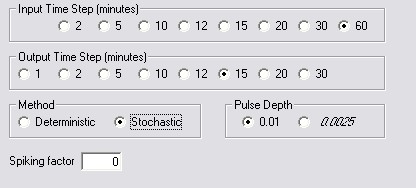|
Short Duration Data Disaggregation
|   |
NetSTORM can disaggregate 2 to 60 minute rainfall data into synthetic 1 to 30 minute increments. The method is derived from a method described by Ormsbee (1989). NetSTORM extends Ormsbee's formulation to allow disaggregation of sub-hourly data to finer resolution, such as converting 15-minute data to 5-minute resolution. The user can choose a minimum stochastic "pulse" depth of either 0.01" as in the paper or 0.01×To ÷ Ti where T = frequency of input and output.

Two methods are offered:
Deterministic - divides data exactly based on patterns in original dataset
Stochastic - adds a random component. This method is suggested for most applications.
Where data is already resolved beyond two decimal places, the deterministic method should be selected or the data should be rescaled to different units.
NetSTORM extends Ormsbee's algorithm by adding a 'spiking' factor for stochastic disaggregation. This enhancement is designed to reproduce sub-hourly extrema that were often not adequately replicated in the original approach. This method 'spikes' the maximum value within a disaggregated dataset by a user-specified factor (between 0 and 1) multiplied by a random value (also between 0 and 1) multiplied by the difference between the original total and the initial maximum value. For instance, in a dataset with hourly precipitation of 1.0, Ormsbee's algorithm might yield 15-minute disaggregated values of 0.20, 0.15, 0.40, and 0.25. With a spiking factor of 0.8, and a randomly-generated factor of 0.5, the 0.4 would be adjusted to 0.4 + 0.8 x 0.5 x (1.0 - 0.4) = 0.64. The other values are adjusted correspondingly downward, yielding 15-minute values of 0.12, 0.09, 0.64, and 0.15. A different random value is computed for each disaggregated hour. Statistics for the resulting sub-hourly dataset should be checked against a rainfall atlas to calibrate the spiking factor. A spiking factor of zero conforms with the original methodology.